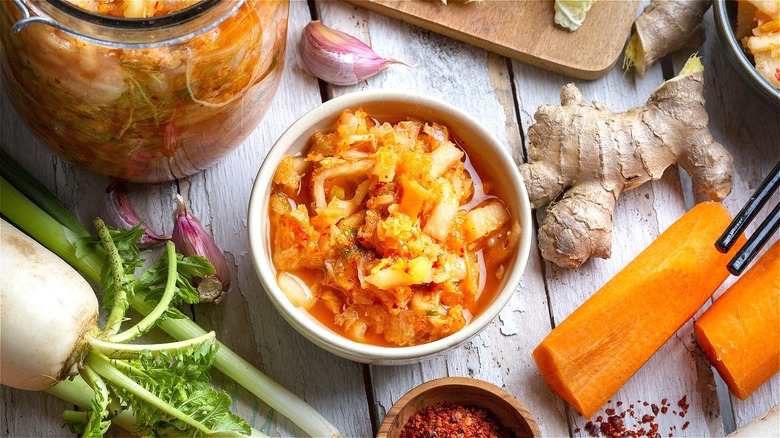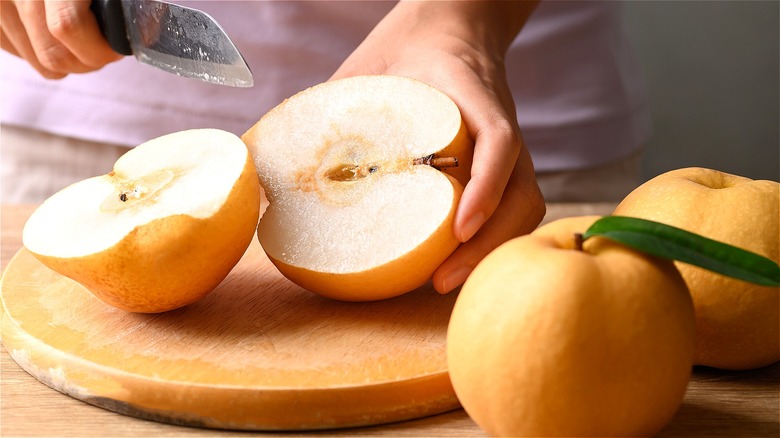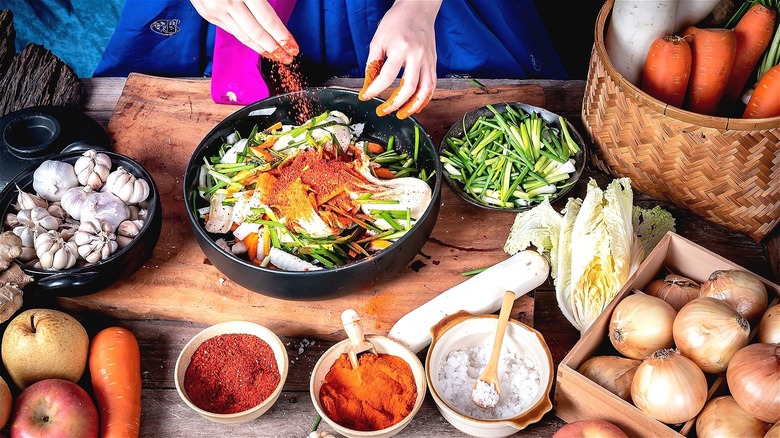The Genius Ingredient Swap For Unbeatable Fresh Kimchi
If you're someone who enjoys adding an extra punch of flavor to scrambled eggs or your favorite fried rice recipe, you may rely on kimchi to get the job done. Kimchi is a fermented Korean side dish made from a colorful range of produce, including napa cabbage, daikon radish, and green onion. It easily offers a slew of meals an extra element of crunchy, tangy goodness. However, if you're used to making kimchi at home and are looking for a way to add more fresh-tasting produce to the mix, you may want to swap out the added sugar for fruit puree.
Sugar is often included in some kimchi recipes to balance spicy seasonings and tangy inclusions, like fish sauce, chopped ginger, and garlic. Believe it or not, fresh fruit is an easy, natural way to enhance the flavor of this fermented accompaniment. Adding fresh apple or pear will brighten the flavor with a bright, fruity essence. Additionally, these fruit varieties have a milder, more nuanced sweetness than traditional cane sugar. Before attempting this fresh-tasting swap for yourself, consider these few helpful tips to make this alternative kimchi-making process a bit easier.
How to successfully incorporate apple or pear into your next batch of kimchi
Before deciding how much fruit you need to successfully upgrade your kimchi recipe, re-familiarize yourself with the taste of your fruit of choice. Some apples and pears have sweeter flavors than others, so taste-testing your selection is essential. You'll also need to blend the fruit into a paste before you can add it to your kimchi. Whether or not you decide to peel your fruit is entirely up to you. According to one 2021 study, the skins of both apples and pears contain an impressive amount of flavor compounds. Therefore, to retain more fresh fruit flavor, consider leaving the peels intact.
You can easily coarsely chop and blend the apples and pears in a high-powdered blender. To achieve an ultra-smooth puree, add a bit of water for easy blending. Alternatively, some baechu (napa cabbage kimchi) recipes include fresh ginger, garlic, and saeujeot (fermented shrimp) in the blended mixture. The fruit-based puree is then poured over and combined with the remaining kimchi essentials, like cabbage, radish, and chili paste. Besides the supreme flavor upgrade that apples and pears provide, these specific fruits have an unexpected qualities that also enhance the resulting texture of your homemade kimchi.
There's more than one reason to add fruit to kimchi
While fruit serves as a natural way to balance out the salty, acidic qualities of homemade kimchi, apples and pears have added benefits that will make your favorite Korean side dish even more delectable. While cane sugar is a tenderizer, so are certain fruits — under the right conditions. Even though Asian pears are best enjoyed raw, these crisp fruits also contain specific enzymes that work to break down coarse or crunchy foods like fibrous meat or in this case, thick cabbage. Blended Asian pears not only give your kimchi a sweet, floral flavor, but they also tenderize the cabbage during fermentation. Asian pears are typically available at high-end, specialty grocery stores like Whole Foods Market or international supermarkets.
Alternatively, even though apples don't contain the same enzymes as Asian pears, these popular fruits are considered acidic based on their somewhat low pH. The apple's acidity gives kimchi an unexpected brightness that may be otherwise missed. You could even use both apple and pear to bring the best of both worlds to this traditional dish. If you're looking to create a kimchi recipe that has an outstanding flavor and consistency, swap out the suggested sugar for bright and refreshing portions of Mother Nature's candy.


